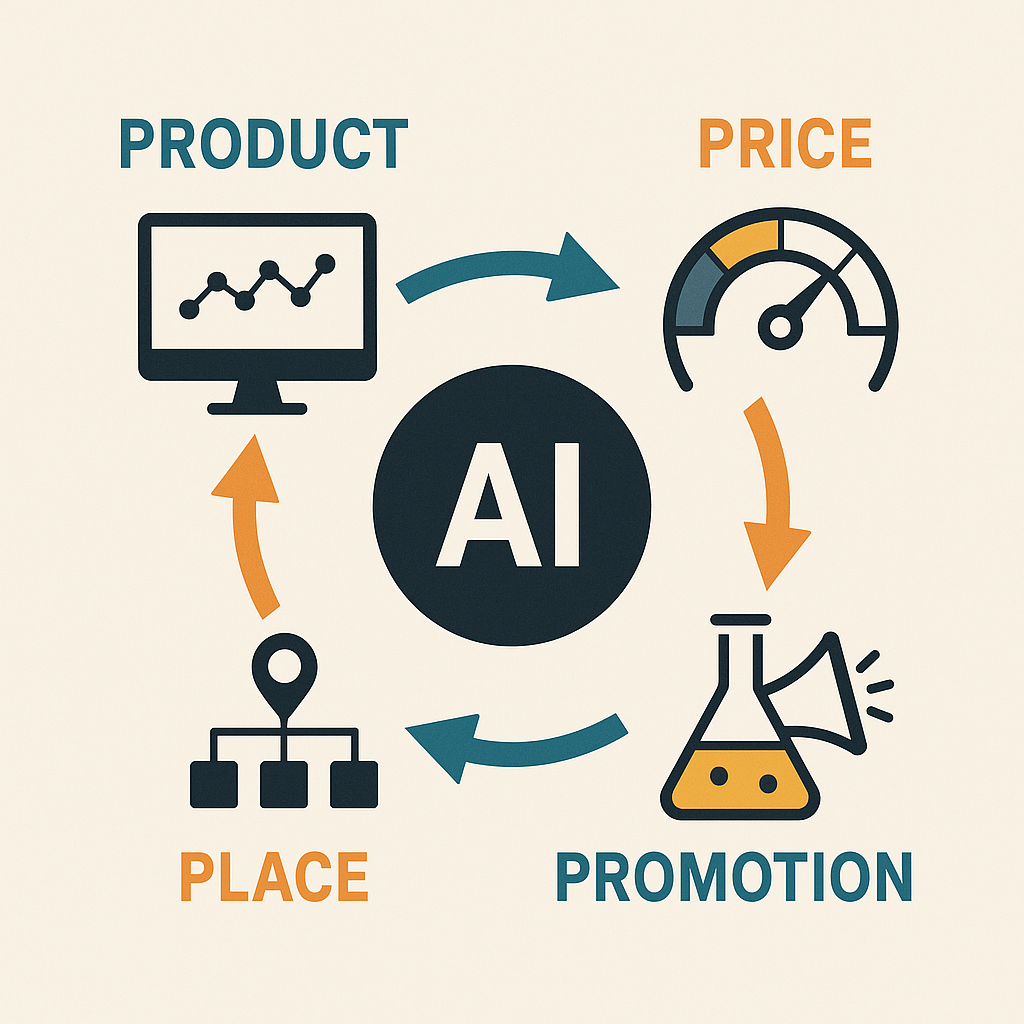For decades, marketers have invoked the 4 Ps — Product, Price, Place, Promotion — as if reciting a mantra from a textbook. Meanwhile, the messy reality of campaigns, tool sprawl, and creative improvisation drifted far from that academic ideal.
But something has shifted. With AI-driven go-to-market systems and continuous workflows, marketing has finally become what it always claimed to be: a measurable science.
Think how easy it is today to go from strategy to execution. A tweak in positioning, a pricing adjustment, a new channel test — done, measured, iterated. The market itself has become our laboratory.

Product — the sensory organ
In the old playbook, the product ended where marketing began. Now it’s the other way around: the product listens.
Every review, Reddit thread, or support ticket becomes data. Large language models turn this noise into structured perception metrics — sentiment scores, emerging themes, clusters of delight or frustration.
Teams like those highlighted by Hyena.ai are already using AI to monitor real-time performance and social sentiment, feeding those signals directly into roadmaps.
Packaging and positioning evolve continuously, too. AI can test variant messaging, onboarding flows, or pricing descriptions, measuring resonance at scale. The product, packaging, and positioning now form a living feedback loop — not a launch.
(Related: Continuous GTM)
Price — the adaptive signal
If Product is how you listen, Price is how you talk back to the market. It used to be a blunt instrument — set once a year, benchmarked against competitors, and left alone. Today, price is a living signal.
AI systems constantly scan competitors, shifting conditions, and sentiment, adjusting perceived value in real time.
The team at PROS calls this shift “from conjoint to continuous,” describing pricing that learns from behaviour instead of static surveys. It lets B2B companies model willingness to pay as fluidly as a weather forecast.
Gracker describes AI-driven competitive analysis as “no longer a luxury but a strategic imperative,” and Apriorit reports that machine-learning models outperform manual methods, driving up to a 10 % profit lift and 13 % sales increase.
Price has become a feedback channel, not a spreadsheet cell. The marketer no longer sets prices — they train them.
Place — the distribution graph
“Place” once meant shelf space or search rank. Today it means presence in the ecosystem’s reasoning flow.
Every channel — social feed, API marketplace, or embedded integration — can be measured.
And now, AI engines like ChatGPT, Perplexity, or vertical agents have become new distribution nodes.
When someone asks “What’s the best CRM for startups?” and your brand appears in that conversation, that’s placement.
Analysts at ZS note that companies leading with AI build “cross-channel orchestration systems that align marketing, sales, and enablement,” while Impulse Creative reframes the same motion as “stop launching, start looping.”
Your “place” is no longer just where you publish — it’s where your brand exists in the world’s reasoning graph.
(See also: The Stack: GTM as Code)
Promotion — the continuous narrative
Promotion has matured from campaign bursts into a continuous feedback loop.
Every post, prompt, and interaction is an experiment testing narrative fit — tone, timing, and emotional resonance.
AI enables this at scale, generating message variations, scoring engagement, and adapting content in real time.
Guardrails like Content Linting keep the brand coherent, but the real magic lies in the loop itself.
As Impulse Creative describes, GTM is now “a continuous, multifaceted engine,” not a single event.
You’re not broadcasting anymore — you’re orchestrating resonance, refining storytelling through measurement instead of hunches.
Why the 4 Ps matter more now
In the age of AI GTM, the 4 Ps aren’t relics — they’re reactive variables. Each one can be observed, modelled, and optimised.
MarketingProfs notes that while the 4 Ps remain foundational, the 4 Ms — Market intelligence, Modelling, Mix, and Measurement — bring them to life.
Continuous GTM fuses these two frameworks: the conceptual clarity of the 4 Ps with the empirical muscle of AI-driven feedback loops.
It’s what marketing theory was always aiming for — a discipline grounded in experimentation, iteration, and truth.
Back to the Lab (and Forward)
AI didn’t make marketing mechanical. It made it empirical.
The lab is no longer on campus — it’s inside your dashboards, feedback pipelines, and customer loops.
Founders, marketers, and engineers now share the same workspace: systems that learn.
You remain the experimenter. The tools simply make the experiment continuous.
In the age of Continuous GTM, you don’t just plan — you operate, learn, and iterate.
The market itself is your lab.
And yes: think how easy it is today to go from strategy to execution.
Share this post
Related Posts
Subscribe to the Newsletter
Get the latest insights on vibe coding and marketing delivered to your inbox.